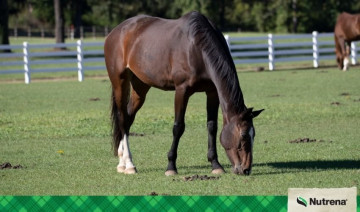
Manage Pasture to Help Control Horse Feed Costs
Managing pasture can be a very important tool in controlling feeding cost for all livestock, particularly horses being kept on small acreages. If pasture is going to provide a substantial amount of the required nutrition for a horse, it takes about 2-3 acres per 1100 pound adult horse.
There are a number of key steps in managing pastures, particularly small acreages
- Do not turn the animals out on pasture too early in the spring. Forages need some growth to recover from the winter and allow root systems to develop.
- Do not turn animals out on tall cool season grasses such as brome grass and orchard grass until the plants are 8-10 inches tall.
- If pastures are short cool season grasses such as Kentucky blue grass or rye grass, the plants should be 6-8 inches tall before grazing.
- If you do not know your pasture composition, err on the side of allowing adequate growth before grazing.
- Remove animals from the pasture when plants are grazed down to 3-4 inches in height. Grazing too early or too long and allowing animals to eat the grass off too close to the ground will kill the grass and turn the pasture into a dirt lot where the only green plants are weeds, requiring expensive renovation.
- If you have limited acreage, consider purchasing some temporary fencing so that you can rotate the pasture.
- The outer fencing should be a safe, permanent fencing.
- You can cross fence the pastures with temporary fencing such as capped steel posts and appropriate electric wire.
- By allowing the animals to graze one section, then moving them to another section to allow the first section to recover, total pasture yield can be increased substantially, helping to control total feed costs.
- Clip and drag the pastures after you pull the animals off to control weeds and control parasites and flies.
- Make certain that fresh clean water is available at all times and that salt is available at all times. If you are not feeding a balanced horse feed or ration balancer, offer appropriate mineral free choice as well.
- If space is very limited, keep a dry lot area where animals can be fed and watered to prevent areas of pasture from being overgrazed.
- Check with your local extension team for additional recommendations for your area and for recommendations on fertilizing pastures. Dr. Krishona Martinson at the University of Minnesota, St. Paul, MN has published some excellent guidelines for pasture management.
A small investment in supplies to allow pasture to be managed and rotated can pay for itself in higher pasture yields. Managing the pastures and selecting the right feeds can help manage total yearly costs as well as improve animal health and condition.
The feed room is proudly brought to you by Nutrena and Cargill Animal Nutrition. Learn more about us here. You can see the original blog post here.
